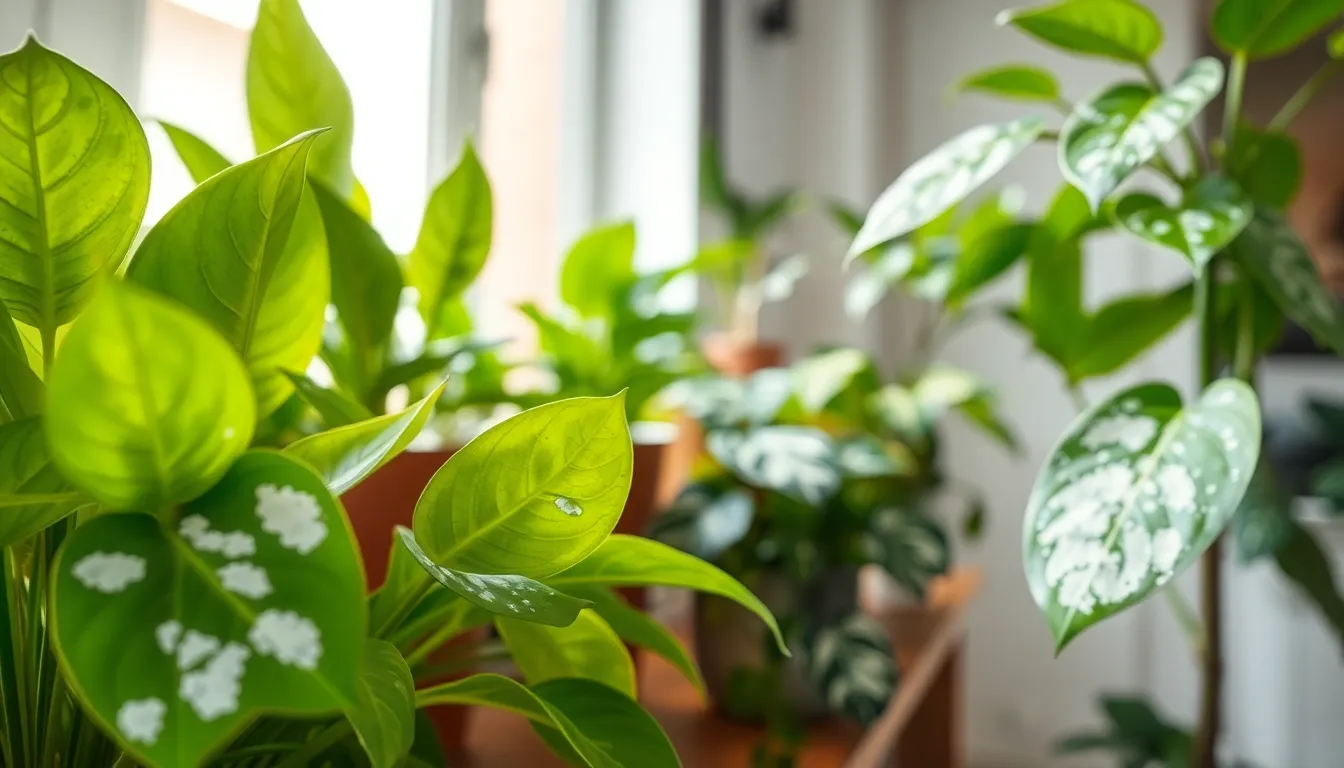Ever glanced at your beloved indoor plants, only to be horrified by the fuzzy white spots that simply scream, “I need help.”? If you’ve noticed powdery mildew lurking on your leafy friends, you’re not alone. This common plant nemesis appears when conditions align just right, and trust us, it can be more than a little frustrating. But fear not. This guide covers everything from understanding powdery mildew and its causes to prevention and treatment, helping you restore your plants from the brink of doom. So grab your gloves, and let’s jump into the world of indoor plant care.
powdery mildew white spots on indoor plants

Powdery mildew is a fungal disease characterized by its distinct white, powdery spots. It tends to pop up when the humidity is high, and temperatures are mild. This sneaky fungus loves to cling onto leaves, stems, and buds, which can lead to some unsightly decor in your home. Don’t be fooled: while it might look harmless, it can stunt growth and even knock your plant out of commission if left untreated. You might think of it as the party crasher of the plant world, unnoticed at first but gradually taking over.
Understanding powdery mildew goes beyond just recognizing its appearance. Fungi thrive on organic material and can reproduce rapidly under the right conditions, making prevention crucial. With the right care and knowledge, you can keep your indoor garden thriving.
Causes Of Powdery Mildew
So, what’s the deal with powdery mildew? Several factors can set the stage for this unwelcome guest. First off, overcrowding your plants is like stuffing too many people into a small car, it creates the perfect atmosphere for disease. Poor air circulation is another significant culprit: without adequate airflow, moisture accumulates, giving fungi the ideal breeding ground.
Next, let’s talk humidity. High humidity levels will certainly encourage powdery mildew to throw a wild party on your plants. Also, if your watering schedule is erratic, you might create an environment where leaves remain damp for too long, making it all but certain that mildew would join the fun. Finally, be cautious about introducing new plants into your indoor jungle, as they can bring pests and diseases into your home.
Identifying Powdery Mildew
Identifying powdery mildew can begin with a careful visual inspection. The first sign is often those telltale white spots that appear on the leaves. These spots usually start small but can quickly develop into larger patches, resembling a dusting of flour. Occasionally, you might notice a yellowing of leaves or distortion in new growth as the mildew takes hold.
To confirm if what you see is indeed powdery mildew, try running your fingers over the spots: if a fine powder comes off, congratulations. You’ve officially diagnosed your plant’s issue. But, don’t fret: this doesn’t mean your plant is beyond saving. The sooner identification occurs, the better the chances for recovery.
Preventing Powdery Mildew On Indoor Plants
Prevention is key, and it starts with good air circulation. Make sure to space your plants adequately to ensure that airflow can circulate freely. Consider using a fan for consistent air movement, especially in closed spaces.
Controlled watering goes a long way as well. Be cautious to water your plants early in the day: this allows any moisture on the leaves to evaporate before the sun goes down. Another clever trick? Rotate your plants occasionally to ensure even sunlight exposure, this helps keep the humidity levels down.
Also, keep an eye on your indoor environment. Ensure that humidity levels are kept in check, ideally between 40% and 60%. If your space is too humid, consider a dehumidifier. Remember, an ounce of prevention is worth a pound of cure.
Treating Powdery Mildew
If your plants already have powdery mildew, swift action is necessary. Start by isolating affected plants to prevent the spread to healthy ones. Prune away heavily infested leaves and dispose of them, don’t compost them.
Next, a mixture of water and baking soda (1 tablespoon per gallon of water) can be a viable treatment option: it helps to change the pH on leaf surfaces, making it harder for the fungi to thrive. Another option is neem oil, a natural fungicide that can effectively mitigate mildew. Spray it on the leaves following the recommended usage directions.
For severe cases, you may need to resort to commercial fungicides. Just ensure that you follow the application guidelines carefully to avoid further damaging your plants. But remember: treating powdery mildew is a process: it may require multiple applications and ongoing management for complete eradication.
Best Practices For Plant Care
Healthy plants are far less susceptible to diseases. Regularly check your plants for signs of distress or anomaly. Establish a routine for watering, ensuring that your plants are neither overwatered nor underwatered, as balance is vital.
Fertilizing your plants appropriately will promote healthy growth. Proper nutrition can bolster a plant’s defense against diseases. Also, keep your plants clean by gently washing them with a damp cloth occasionally: this eliminates dust and debris while allowing your plants to breathe better.
Finally, diversify your plant collection. For example, some plants naturally repel pests or diseases. By mixing plants up, you can reduce the likelihood of uniform infections affecting your indoor garden.

